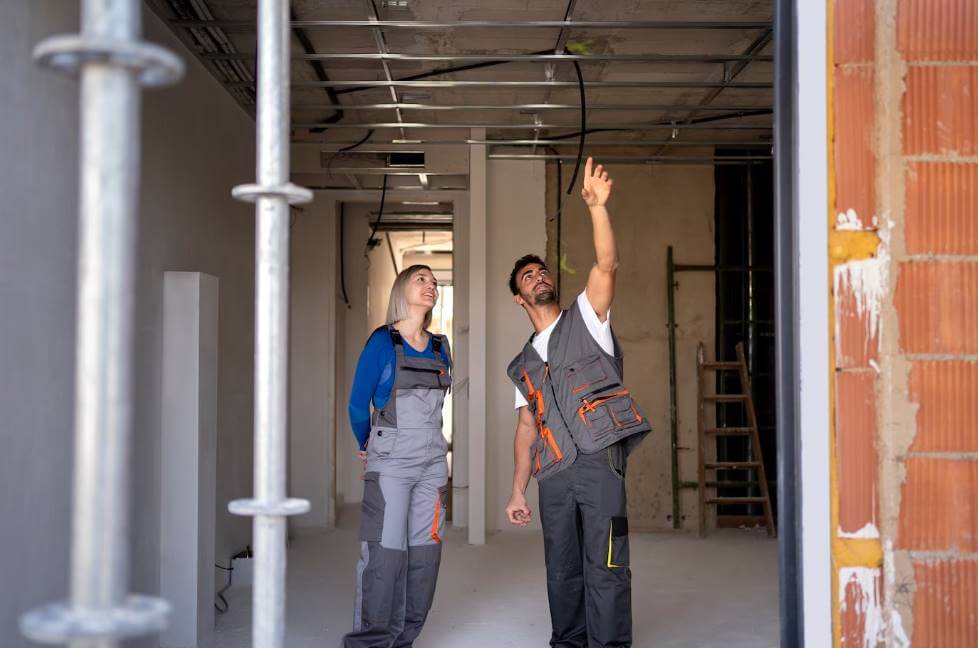Planning a new store layout, restaurant remodel, or office fit-out is exciting. Nonetheless, amid all the excitement, the vital question of "How should you handle structural issues during fit-out?" sometimes arises. This post will assist you with experienced guidance to keep your space intact and secure during the renovation.
In summary, careful preparation and experienced consulting are your best allies in addressing structural difficulties throughout a fit-out. The next in-depth article will discuss the tactics and factors to consider when dealing with structural difficulties. Let's explore structural solutions and design alternatives to ensure your space's transformation goes off without a hitch as you begin your fit-out journey.
During a fit-out, addressing structural difficulties is essential for everyone's safety, but it also presents exciting new possibilities for creative layouts and economical answers. With the help of famous specialists in the industry, we'll delve into this fascinating facet and provide you with a road map for a successful fit-out project that extends beyond superficial appearances.
Pre-Planning For Success
Floor and ceiling installations, wall construction, and furniture assembly are all examples of fit-out tasks. The fitting-out process may also include the installation of building utilities, including cabling, wiring, Internet access, and communication systems.
Which Fit-Out Varieties Are There?
Three broad types of commercial fit-outs exist: Category A, Category B, and Shell-Core. When outfitting a business, it's helpful to have a firm grasp on the particulars of each area.
Shell And Core Fit-Out
The basic structure of the building is complete and needs to be outfitted. The building's façade may look complete from the outside, but it's still missing the likes of electricity, inside walls, lighting, and heating. A company can modify an existing building to meet its needs via a "shell and core" fit-out. This works well for corporations that need a lot of room.
Category A Fit-Out

Pre-leased commercial spaces often include Category A fit-outs. This is a working unit with installed utilities, like electricity and plumbing. Standard features included in a category A fit-out could include:
- Toilets
- Raised access floors
- Electrical outlets
- HVAC systems
- Grid ceiling
- Fire protection systems
Although the room serves its purpose, it may benefit from other design elements. At this point, a company can move in and begin using a Category B design:
Category B Fit-Out
Category B fit-out refers to a design that considers your company's requirements and reputation. This refurbishment includes the addition of facilities not present in Category A. Category B refers to the customization of the physical space to the needs of the company through the use of aesthetic design principles.
Window treatments, furniture, lighting, flooring, partitioning, painting, branding, and more may all be part of this stage. Category B's design is at its strongest when it reflects the organisation's values, norms, team composition, and procedures as a whole. This is your chance to present your brand in a way that reflects your inventiveness and sense of professionalism.
Structural Issues
It rains, and you find a leak; rust stains mar the exterior of your building; the bricks or render bulge, fret, or crack; or all of the above.
What you see as a small cosmetic problem may be an early indicator of more serious underlying structural damage. Fixing a structural problem as soon as possible can save money and inconvenience later. Here are several warning indications that your building may have structural problems:
- There are spots of rust on the outside of your structure that have no rhyme or reason.
- Step-like cracks that occur on the inside or outside of a building and travel upwards or downwards.
- Problems with water leaks or concrete cancer that cannot be pinpointed to a specific location above the leak.
- Caused by the brick's growth or expansion, the building's foundation may shift, and the windows and doors may no longer close securely.
- Corrosion and brickwork are cracking on the lintels and arch bars (above the doorways and windows).
- Balconies with structural damage and water seepage.
- Huge chunks of concrete are breaking off the building.
Many Different Things Can Cause Problems With The Structure.
Your structure may be experiencing structural issues for several reasons, including age, exposure to the elements, or the use of subpar materials and artistry. Here are a few frequent causes of major structural damage:
- Construction flaws due to sloppy effort. Sometimes, construction crews forget to leave a sufficient distance between the surface and the reinforcing, allowing water to penetrate the material. This results in a chemical interaction between the concrete and the steel, which leaches the concrete.
- Putting together a variety of components that aren't meant to work together. A chemical reaction triggered by these brings on rusting.
- Mechanical breakdown.
- Cracked concrete floors that let water seep into the walls.
- Putting in new things, such as air conditioners or anchors, usually on the roof. Water damage can occur if waterproof barriers are drilled through to install equipment and if the holes are not securely sealed after installation.
- Subpar lighting. Water can enter the cavity if the flashings are fitted incorrectly or not far enough into the wall cavity. Even if placed correctly, water can flow into the cavity during heavy rains if the drains are not emptied.
The Do’s & Don't Of A Successful Office Fitout
There are several factors to consider when carrying out a commercial office fitout, and failure to do so can result in financial and legal losses for the company. Since we deal with these demands daily as fitout specialists, let's let you know a few secrets about where your focus should be to avoid common mistakes in the workplace.
Is There Anything That Could Go Wrong?
So, quite a bit! Workplace ergonomics, accessibility, compliance with Occupational Health and Safety (OHS) requirements, etc., must be considered during the design and construction of any office. In addition, the construction process itself necessitates strict adherence to HSE measures, additional OH&S measures, and intensive project management. When a project is poorly planned or carried out, extra problems arise. Here is a handy checklist of things to remember as you plan your next office renovation or commercial office fitout.
Do
Plan In Advance

As obvious as it may be, planning is the most crucial part of an office remodel. Making a detailed plan for an office remodel ensures that everyone involved in the project, from architects to builders, works on the same page.
At this juncture, the three most pressing issues are objectives, resources, and a timetable. You can only move on to second or third-level issues once you've nailed down the basics. If your workplace is undergoing renovations, a secondary consideration should be whether or not to relocate to a temporary location. Whether or not building dates fall with the office vacation break (timeline) depends on the scope of the build (goals), leasing costs (budget), and other factors.
A more organised workflow and fewer misunderstandings result from a clearly defined plan with defined lines of action, reporting structure, and accountability. In other words, if you can iron out the kinks now, don't put it off until later. If you need help with what to do, the safest bet is to prepare beforehand.
Work With Building Management
Verifying that all building works comply with the building's specifications, rules, and other requirements is crucial, as 95% of office fit-outs occur within a commercial office structure. Having someone on your team who is knowledgeable about the processes for gaining clearance to ensure adherence to construction standards and laws is helpful. Getting things approved swiftly and on the budget from building management requires a great degree of patience and availability when working with compliance.
Don’t
Different Contacts for Site Access
The Project Manager is responsible for organising and directing all on-site work related to the project. This entails coordinating the timely arrival of all on-site trades and materials suppliers.
The Project Manager must be able to restrict site access for various teams based on the planned work schedule. This reduces the likelihood of a bottleneck occuring between the various trades and suppliers.
Leave Tradespeople Alone
It is unrealistic to assume that tradespeople will cooperate well with the other teams without a Design and Fitout PM Team outlining their contribution's precise deadlines and order.
A mistake in the sequence could have disastrous results. Imagine if the plumbers running the pipes showed up after the floor tiles were installed, or worse, if they didn't connect the waste pipes at all! Such blunders might cause the project schedule and budget to balloon out of proportion.
Monitoring Progress: Ensuring a Smooth Fit-Out Process
It's thrilling to take on a fit-out job, whether it's for your own house or a commercial establishment. However, keep in mind that effective progress monitoring throughout the process is often the key to the success of such projects. In this blog, we'll discuss the need for real-time monitoring systems, the methods for keeping tabs on potential structural problems, and the steps to take if fresh problems crop up.
Stress Continuous Monitoring During Fit-Out
Different groups, contractors, and design/construction phases contribute to the complexity of the fit-out process. Constant monitoring is not an option if you want things to go off without a hitch.
- Quality Assurance: Constant inspection ensures the completed work meets your specifications and industry norms. This involves making sure all structural components are set up securely and reliably.
- Timeline Adherence: Monitoring the project's development and determining if it is on time is invaluable. The ability to quickly react to any delays or setbacks that may occur is facilitated by early detection.
- Cost Control: Monitoring the project closely can help cut costs and avoid delays. Costs can balloon, for example, if structural problems are ignored.
Discuss Ways To Track Structural Issue Progress.
The advancement of technology has allowed us to access a wide variety of resources that make tracking progress on fit-out projects much simpler:
- Project Management Software: Keep track of projects, deadlines, and finances with the help of project management software. You may get up-to-the-minute reports on the project's development using software like Trello, Asana, or Microsoft Project.
- Regular Site Inspections: Schedule frequent inspections or site visits to verify progress. Sometimes, digital data can hide structural problems or variations from the plan, but on-site inspections can identify them.
- Collaborative Communication: Encourage honest and productive dialogue between all parties involved in the project. Potential issues can be spotted early with frequent meetings and updates on progress.
Discuss How To Adjust For New Issues
Unanticipated difficulties can arise in fit-out projects despite meticulous planning and close monitoring. It is critical to act quickly when discovering new structural problems:
- Immediate Assessment: When an issue emerges, it's important to gather input from everyone involved to determine how much of a toll it will have on the project's schedule and budget.
- Revised Plans: Modify existing project plans as necessary. Adjusting the project schedule, shifting resources, or changing the design may all be necessary.
- Documentation: Document any alterations in great detail, including justifications, expenses, and effects on the project as a whole. In the event of a dispute or legal action, having this record is invaluable.
Frequently Asked Questions About Fit-Outs
Alterations to buildings typically necessitate permission from relevant authorities. Contact the local building department to secure the appropriate permits before making any structural changes during a fit-out.
Steel beam reinforcement, floor levelling, and additional support for heavy fixtures are standard structural solutions. Your fit-out may have a longer lifespan if you take these precautions.
Ensure your fit-out's aesthetic goals are communicated to both your interior designer and architect. They can disguise architectural details by incorporating them into the design itself.
Preventing structural problems by keeping up with routine maintenance is essential. Ensure your fit-out lasts as long as possible by inspecting it often, fixing any signs of wear and tear immediately, and doing regular maintenance.
When doing structural work during a fit-out, it is important to check your insurance policies. Make sure your insurance covers any alterations to the structure. If you feel the need, look into getting more insurance.

